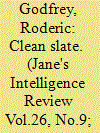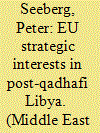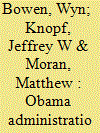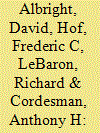|
|
|
Sort Order |
|
|
|
Items / Page
|
|
|
|
|
|
|
| Srl | Item |
| 1 |
ID:
133690


|
|
|
|
|
| Publication |
2014.
|
| Summary/Abstract |
As Syria's declared chemical weapons are destroyed, Roderic Godfrey assesses whether their destruction has stopped the Syrian regime from contravening its new international obligations, and the dilemma faces by the international community.
|
|
|
|
|
|
|
|
|
|
|
|
|
|
|
|
| 2 |
ID:
130939


|
|
|
|
|
| Publication |
2014.
|
| Summary/Abstract |
Since the fall of Muammar Qadhafi in 2011, a legitimate monopoly over the means of violence has not been in the hands of the Libyan state. The military confrontation between the regime and what the international media called the "rebels," supported by the NATO no-fly zone, ended in October 2011. However, in 2012 and especially in 2013, Libya witnessed an escalating conflict pitting the democratically elected government and the Libyan state against armed groups and militias. For the EU, this is a challenge to its strategic interests, primarily security in the Mediterranean and secondarily migration and the development of Libya.
|
|
|
|
|
|
|
|
|
|
|
|
|
|
|
|
| 3 |
ID:
177064


|
|
|
|
|
| Summary/Abstract |
This article examines responses to the Syrian government’s possession and eventual use of chemical weapons (CW) in that country’s civil war from 2012 to 2013. During this time, the United States and other outside powers applied coercive strategies, in both deterrent and compellent modes. Outcomes varied: compellence in the form of coercive diplomacy achieved a partial success, getting Syria to give up much of its chemical stockpile, but there were multiple deterrence failures, culminating in a large-scale sarin gas attack in August 2013. We examine this record to draw lessons about factors associated with the effectiveness of coercion. Our analysis draws on insights from existing research on both deterrence and coercive diplomacy to develop an integrated analytical framework involving the interplay of three factors: credibility, motivations, and assurance. We find the typical default approach to coercion, based on demonstrating toughness and threatening to impose costs using airpower—an approach we call the “resolve plus bombs” formula—was not sufficient to change Syria’s calculations regarding chemical use.
|
|
|
|
|
|
|
|
|
|
|
|
|
|
|
|
| 4 |
ID:
131609


|
|
|
|
|
| Publication |
2014.
|
| Summary/Abstract |
The effort to destroy Syria's chemical weapons program made little visible progress in May as none of the chemical weapons materials remaining in Syria were shipped out of the country for destruction.
Also last month, a team from the Organisation for the Prohibition of Chemical Weapons (OPCW) investigating allegations of chlorine attacks in Syria had to turn back from the site it was investigating and return to Damascus after it came under assault.
Under a schedule set last November by the OPCW Executive Council, the highest-priority chemicals among Syria's declared stockpile of 1,300 metric tons were to be shipped out of the country by Dec. 31 for destruction elsewhere. Most lower-priority materials were to be out by Feb. 5, and Syria was to destroy the rest of the material domestically
|
|
|
|
|
|
|
|
|
|
|
|
|
|
|
|
| 5 |
ID:
130931


|
|
|
|
|
| Publication |
2014.
|
| Summary/Abstract |
In my 40 years in the region, I can't remember so many big front-page issues. Egypt, Syria, Iraq, Afghanistan and Iran. All are major problems at the same time, and there are lots of doubts about the U.S. role. Traditional allies are expressing concern and in some cases anger, wondering if the United States is actually a reliable ally. Today's topic lies at the heart of many of these concerns. We are very fortunate to have with us today a panel of true Middle East experts who have real-time, on-the-ground experience in the region.
|
|
|
|
|
|
|
|
|
|
|
|
|
|
|
|
| 6 |
ID:
131831


|
|
|
|
|
| Publication |
2014.
|
| Summary/Abstract |
ON SEPTEMBER 27, 2013, the Security Council of the United Nations unanimously adopted resolution 2118 in support of the decision of the Organization for the Prohibition of Chemical Weapons (OPCW) made on the same day in The Hague to place Syrian chemical weapons under international control and dismantle them. This was the culmination of the Ministerial Week at the 68th session of the UN General Assembly in New York, an event which was expected by all, but not all believed that it would happen. All, however, eventually acknowledged that it came about largely through to the efforts of Russian diplomats who, led by Foreign Minister Sergey Lavrov, negotiated day after day with the U.S. partners, seeking a solution which not only would avert the threat of a military strike against Syria, but would also open the way for politically resolving the most complicated crisis in the SAR.
|
|
|
|
|
|
|
|
|
|
|
|
|
|
|
|
|
|
|
|
|